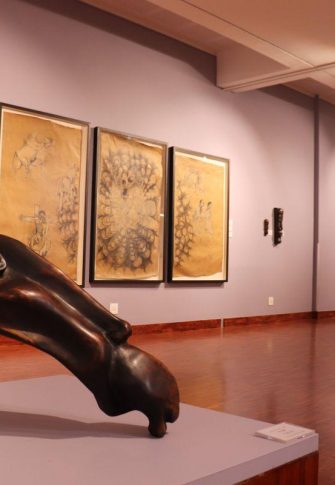The question of Africa’s authentic voice within modernity can only be resolved within history. History contains both what is imposed upon it – often an ideology – and what confronts and transgresses it in an endeavour to maintain the ability of human imagination to create with total freedom.
— Rasheed Araeen
To reflect on the life and work of Louis Khehla Maqhubela (1939–2021) is to reflect on the history of South African art and the discourse on African modernism(s) — with its limitations, its poverty of language. In a very quiet way, Maqhubela’s practice points us to what Araeen refers to as an endeavour to create with total freedom. Born in Durban, Maqhubela was an abstract modernist painter whose career began with drawing and watercolour painting. A lesser-known aspect of his career includes creating mosaics for hospitals and schools in Soweto in the early 1960s.
A pioneer in abstract modernism, Maqhubela received mentorship from artists Cecil Skotnes and Sydney Kumalo through the Polly Street Art Centre in Johannesburg. His time at the centre, during the late 1950s, intersected with fellow students Ben Arnold and Ezrom Legae, both of whom blended classic African and modernist styles influenced by observations and interpretations of daily life. A lifelong learner, Maqhubela attended Goldsmith College (1984) before transferring to the Slade School of Fine Art (1985–1988) for a Post Graduate Diploma in Printmaking, in London where he later settled.
The early 1980s saw a radical shift in his practice. Revived by his travels and the change in environment from the oppressive regime of apartheid towards Europe, his later works reveal a marked shift from realism towards abstraction. However, Maqhubela did not abandon representation altogether; through the meticulous use of a thin black line, he would often overlay his abstract compositions with depictions of everyday objects, including outlines of figures and animals.
Maqhubela’s work conveys a deep interest in geometrical constructions. In an interview with the former director of the South African National Gallery, Marilyn Martin, preceding his travelling retrospective survey, ‘A Vigil of Departure – Louis Khehla Maqhubela: a retrospective 1960–2010,’ the artist noted: “The law of the triangle is a beautiful, simple, universal law, underlying all physical and ‘spiritual’ manifestations. The circle – beloved from pole to pole – infinity expressed in a simple line!” His 1970 painting, Composition with a Bicycle, indicates some of these principles. The evocative use of colour, coupled with a gradation in hues, shapes different elements through rhythm and sound. The work suggests a merger between musicality and poetry, art forms that had a great influence on his artmaking. More broadly, Maqhubela’s work is characterised by winding lines that produce compositions that sing. His lifework contributed greatly to South Africa’s painting tradition and the development of a language for Black artists who engaged both local and global techniques in their artmaking.










